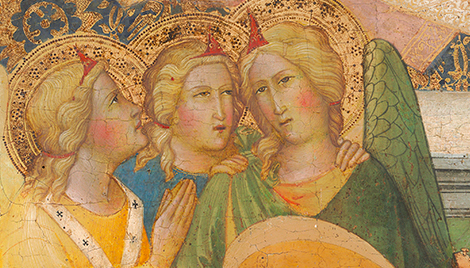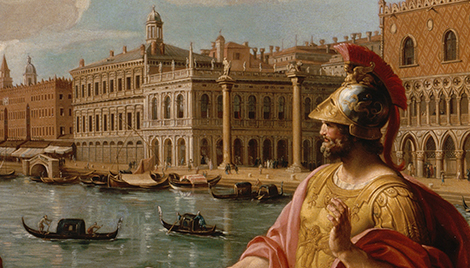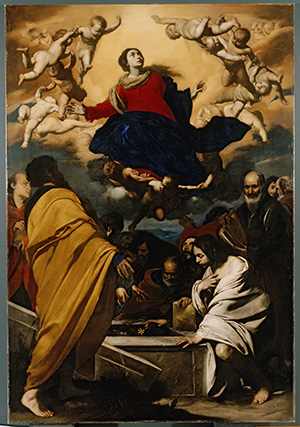The Assumption of the Virgin
The Assumption of the Virgin
- Artist
- Massimo Stanzione
- Artist Dates
- c. 1586-c. 1656
- Artist Nationality
- Italian
- Title
- The Assumption of the Virgin
- Date
- c. 1630-35
- Medium
- oil on canvas
- Dimensions
- 275.6 x 189.5 cm (108-1/2 x 74-5/8 in)
- K Number
- K2112
- Repository
- North Carolina Museum of Art
- Accession Number
- GL.60.17.52
- Notes
Provenance
Francis Cook, 1st Bart. [1817-1901]), Doughty House, Richmond, Surrey; Sir Frederick Lucas Cook, 2nd Bart. [1844-1920], Doughty House; Sir Herbert Frederick Cook, 3rd Bart. [1868-1939], Doughty House; Sir Francis Ferdinand Maurice Cook, 4th Bart. [1907-1978], Doughty House, and Cothay Manor, Somerset; sold through (Rosenberg & Stiebel, Inc., New York); to the Samuel H. Kress Foundation on 8 February 1955; gift 1960 to North Carolina Museum of Art, no. GL.60.17.52. [1] Lent by Cook to the National Exhibition of Works of Art, Leeds, 1868 no. 45, in whcih the catalogue states he acquired the painting in Grenada in 1863. Fern Rusk Shapley, Paintings from the Samuel H. Kress Collection, Italian Schools, XVI-XVIII Century, London, 1973, p. 96, give the earlier provenance as The Hon. Henry Wellesley, 1st Baron Cowley, Somerset; Henry Richard Wellesley, 1st Earl Cowley, Somerset, from 1847; (his sale, Christie's, London, 18 July 1885, no. 27). However since it was owned by Cook by 1868, this is not possible.
Catalogue Entry
Massimo Stanzione
The Assumption of the Virgin
K2112
Raleigh, N.C., North Carolina Museum of Art (GL.60.17.52), since 1960.(1) Canvas. 108 1/2 x 74 5/8 in. (275.6 x 189.6 cm.). Fair condition; some restoration in some figures and around edges of canvas; cleaned 1960. The attribution of K2112 to the Spanish painter Alonso Cano persisted from the first notice we have of the painting, in 1868,(2) until about 1930, although as early as 1910 a brief for Stanzione's authorship had been presented.(3) The painting is not without Spanish characteristics, which Neapolitan artists could acquire from Ribera. But its monumental figures have a grace and gentleness that artists like Caracciolo, Cavallino, and Stanzione developed in their interpretation of Caravaggio's naturalism. Parallels in Stanzione's oeuvre are plentiful. A significant example is the Holy Family Resting in a Rocky Landscape, in the Ringling Museum, Sarasota, Fla., where the floating putti bear the closest possible resemblance to those in K2112; the Joseph is like the apostle with a book standing at the right in K2112; and still-life details are treated with similar effects. The Ringling picture is signed with the artist's monogram, together with his title of knighthood, which was conferred during his second sojourn in Rome and thus indicates a terminus post quem of 1625 for the Ringling picture and hence, very likely, for K2112 also. Provenance: Sir Henry Wellesley, later Lord Cowley, Minister to Madrid 1810-22 –exhibited: 'National Exhibition of Works of Art,' Leeds, 1868, no. 45 of catalogue (where said to have been bought in Granada in 1863), as The Virgin in Glory, by Cano. Cowley sale, Christie's, London, July 18, 1885, no. 27, as Cano. Cook Collection, Richmond, Surrey (abridged catalogue, 1903, p. 22, no. 6, as Cano; catalogue by M. W. Brockwell, vol. III, 1915, no. 514, as Cano, with possibility of Stanzione; abridged ed., 1932, p. 63, no. 514, as Stanzione) –exhibited: 'Spanish Art,' New Gallery, London, 1895-96, no. 142, as Cano; 'Spanish Old Masters,' Grafton Galleries, London, Oct. 1913-Jan. 1914, no. 73, as Cano; 'Holbein and Other Masters,' Royal Academy, London, Dec. 9, 1950-Mar. 7, 1951, no. 321, as Stanzione. Rosenberg and Stiebel's, New York. Kress acquisition, 1955 –exhibited, after entering the North Carolina Museum: 'Art Treasures for America,' National Gallery of Art, Washington, D.C., Dec. 10, 1961-Feb. 4, 1962, no. 87, as Stanzione.
References
(1) Catalogue by F. R. Shapley, 1960, p. 106, as Stanzione. (2) When exhibited at Leeds (see A. Graves, A Century of Loan Exhibitions, vol. I, 1913, p. 149, no. 45). J. C. Robinson (in Burlington Magazine, vol. XI, 1907, p. 325) published K2112 as Cano. See also the attributions to Cano cited in Provenance. (3) By H. Voss (in Der Cicerone, vol. II, 1910, pp. 9 f.), who was followed by C. Phillips (in Daily Telegraph, Oct. 28, 1913). C. Ceci (in Thieme-Becker, Allgemeines Lexikon, vol. XXXI, 1937, p. 473) implies an attribution to Stanzione. And H. E. Wethey (Alonso Cano, 1955, p. 186) lists K2112 among paintings wrongly attributed to Cano and labels it 'Neapolitan School, XVII Century.' See also attributions to Stanzione under Provenance.






